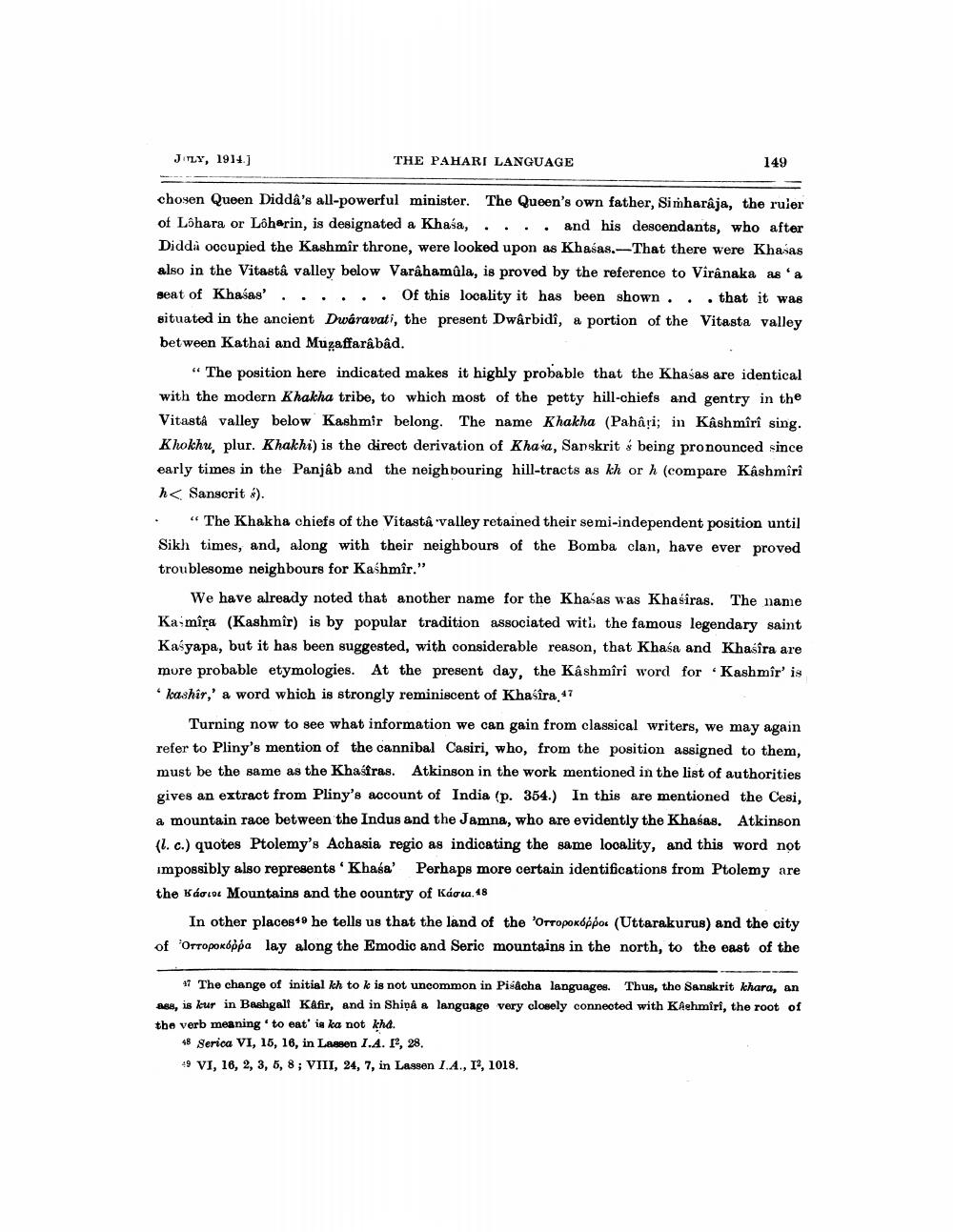________________
Jiny, 1914.]
THE PAHARI LANGUAGE
149
chosen Queen Didda's all-powerful minister. The Queen's own father, Simharâja, the ruler of Löhara or Lôherin, is designated a Khaśa, ... and his descendants, who after Didda oooupied the Kashmir throne, were looked upon as Khasas.--That there were Khašas also in the Vitastâ valley below Varahamůla, is proved by the reference to Virânaka asa seat of Khaśas' .....Of this locality it has been shown ... that it was situated in the ancient Dwaravati, the present Dwârbidi, a portion of the Vitasta valley between Kathai and Muzaffarâbâd.
“The position here indicated makes it highly probable that the Khasas are identical with the modern Khakha tribe, to which most of the petty hill-chiefs and gentry in the Vitasta valley below Kashmir belong. The name Khakha (Pahâri; in Kashmiri sing. Khokhu, plur. Khakhi) is the direct derivation of Khaia, Sanskrit á being pronounced since early times in the Panjab and the neighbouring hill-tracts as kh or h (compare Kashmîrî h< Sanscrit 6).
"The Khakha chiefs of the Vitastâ valley retained their semi-independent position until Sikh times, and, along with their neighbours of the Bomba clan, have ever proved troublesome neighbours for Kashmir."
We have already noted that another name for the Khasas was Khasiras. The name Ka mîra (Kashmir) is by popular tradition associated with the famous legendary saint Kaśyapa, but it has been suggested, with considerable reason, that Khasa and Khasira are mure probable etymologies. At the present day, the Kashmîrî word for Kashmîr' is * kashir,' a word which is strongly reminiscent of Khasîra 47
Turning now to see what information we can gain from classical writers, we may again refer to Pliny's mention of the cannibal Casiri, who, from the position assigned to them, must be the same as the Khasiras. Atkinson in the work mentioned in the list of authorities gives an extract from Pliny's account of India (p. 354.) In this are mentioned the Cesi, a mountain race between the Indus and the Jamna, who are evidently the Khabas. Atkinson (l. c.) quotes Ptolemy's Achasia regio as indicating the same locality, and this word not impossibly also represents Khasa Perhaps more certain identifications from Ptolemy are the Kάσιοι Mountains and the Country of Kάσια. 18
In other places49 he tells us that the land of the 'Ortopokópos (Uttarakurus) and the city of Ortopokóộpa lay along the Emodic and Seric mountains in the north, to the east of the
47 The change of initial kh to k is not uncommon in Pisacha languages. Thus, the Sanskrit khara, an ase, is kur in Bashgall Kafir, and in Shipà a language very closely connected with Kashmiri, the root of the verb meaning to eat' is ka not khd.
48 Serica VI, 15, 16, in Lassen 1.4.1, 28. 49 VI, 16, 2, 3, 5, 8; VIII, 24, 7, in Lassen L.A., 1, 1018.




